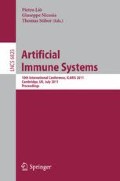Abstract
In this paper a system which optimises parameter values for the Receptor Density Algorithm (RDA), an algorithm inspired by T-cell signalling, is described. The parameter values are optimised using a genetic algorithm. This system is used to optimise the RDA parameters to obtain the best results when finding anomalies within a large prerecorded dataset, in terms of maximising detection of anomalies and minimising false-positive detections. A trade-off front between the objectives is extracted using NSGA-II as a base for the algorithm. To improve the run-time of the optimisation algorithm with the goal of achieving real-time performance, the system exploits the inherent parallelism of GPGPU programming techniques, making use of the CUDA language and tools developed by NVidia to allow multiple evaluations of a given data set in parallel.
Access this chapter
Tax calculation will be finalised at checkout
Purchases are for personal use only
Preview
Unable to display preview. Download preview PDF.
References
Apostolico, A., Galil, Z.: Pattern matching algorithms. Oxford University Press, Oxford (1997)
Bell, S., Nazarov, E., Wang, Y.F., Rodriguez, J.E., Eiceman, G.A.: Neural Network Recognition of Chemical Class Information in Mobility Spectra Obtained at High Temperatures. Analytic Chemistry 72, 1192–1198 (2000)
Collange, S., Defour, D., Tisserand, A.: Power Consumption of GPUs from a Software Perspective. In: Allen, G., Nabrzyski, J., Seidel, E., van Albada, G.D., Dongarra, J., Sloot, P.M.A. (eds.) ICCS 2009. LNCS, vol. 5544, pp. 914–923. Springer, Heidelberg (2009)
CUDA C Programming Guide Version 3.1.1. NVIDIA (2010), http://developer.download.nvidia.com/compute/cuda/3_2_prod/toolkit/docs/CUDA_C_Programming_Guide.pdf
Deb, K., et al.: A fast and elitest multiobjective genetic algorithm: NSGA-II. IEEE Transactions on Evolutionary Computation 6, 182–197 (2002)
Eiceman, G., Karpas, Z.: Ion Mobility Spectrometry, 2nd edn. CRC Press, Boca Raton (2004)
Gazit, I., Terkel, J.: Explosives detection by sniffer dogs following strenuous physical activity. Applied Animal Behaviour Science 81, 149–161 (2003)
International Conference on Artificial Immune Systems (ICARIS), Competitions (DSTL: Anomaly Detection in Mass Spectra) (2010), http://www.artificial-immune-systems.org/icaris/2010/competition.html
Nickolls, J., Buck, I., Garland, M., Skadron, K.: Scalable Parallel Programming with CUDA. Queue ACM 6(2), 40–53 (2008)
Owens, N.D.L., Greensted, A., Timmis, J., Tyrrell, A.: T Cell Receptor Signalling Inspired Kernel Density Estimation and Anomaly Detection. In: Andrews, P.S., Timmis, J., Owens, N.D.L., Aickelin, U., Hart, E., Hone, A., Tyrrell, A.M. (eds.) ICARIS 2009. LNCS, vol. 5666, pp. 122–135. Springer, Heidelberg (2009)
Owens, N.D.L., Timmis, J., Greensted, A., Tyrrell, A.: Elucidation of T Cell Signalling Models. Journal of Theoretical Biology 262(3), 452–470 (2010)
Owens, N.D.L., Greensted, A., Timmis, J., Tyrrell, A.: T Cell Receptor Signalling Inspired Kernel Density Estimation and Anomaly Detection. Accepted for publication in the Journal of Theoretical Computer Science (2011)
Owens, N.D.L.: From Biology to Algorithms. PhD Thesis. University of York. Department of Electronics (2010)
Owens, N.D.L., et al.: Robot Mounted Chemical Detection. Submitted to IEEE Transactions on Systems, Man and Cybernetics, Part C (2011)
Zupan, J., Gasteiger, J.: Neural networks: A new method for solving chemical problems or just a passing phase? Analytica. Chimica. Acta. 248, 1–30 (1991)
Author information
Authors and Affiliations
Editor information
Editors and Affiliations
Rights and permissions
Copyright information
© 2011 Springer-Verlag Berlin Heidelberg
About this paper
Cite this paper
Hilder, J.A. et al. (2011). Parameter Optimisation in the Receptor Density Algorithm. In: Liò, P., Nicosia, G., Stibor, T. (eds) Artificial Immune Systems. ICARIS 2011. Lecture Notes in Computer Science, vol 6825. Springer, Berlin, Heidelberg. https://doi.org/10.1007/978-3-642-22371-6_21
Download citation
DOI: https://doi.org/10.1007/978-3-642-22371-6_21
Publisher Name: Springer, Berlin, Heidelberg
Print ISBN: 978-3-642-22370-9
Online ISBN: 978-3-642-22371-6
eBook Packages: Computer ScienceComputer Science (R0)

